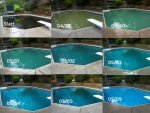Gotcha. I know you've been at this a while. You're heading into the weekend and perhaps that means you can double down a bit on the pool.
I will tell you it took my swamp 12 days in April of 2012, but some of that included stalls and being out of town, and the last several days was really all about filtering...I wasn't actually loosing much chlorine.
The thing I found was that a) you really had to keep getting debris out...eg leaf rake dredging even before trying to vacuum to waste and b) that you really had to "maintain" the slam value or go backwards.
By that, I mean, if I woke up to 10 instead of 12, it meant I'd spent the night NOT at "kill zone." Which in a swamp, really meant going backwards. I feel this drags out the process.
I am just going to tell you what worked in my case, but realize since you've had fading and you have a kit I don't personally know you will choose your own comfort zone/risk level and that your mileage may vary

In my case, my pool was in a very high water table (draining risked the integrity of the pool) and to even do the sheet method would have meant trucking in two truckloads of water at least 1,000 extra and we wouldn't have been able to match the trash pump/fill rates. (Im on an old well with high metals.)
So I really really dialed it in the first week in that after monitoring it super closely on the weekend, I'd come home at lunch, test the FC, and dose high enough to be at slam value still by supper time.
That often meant dosing a little closer to the mustard shock/slam value in Pool Math for my cya...eg if the target was 12 I might go as high as 16 to land back at 12.
Here is the approximately sequential visual log of color change you can expect if the slam is maintained and your filter is operating correctly and you've hand raked the majority of debris out.
Hope that hels give you some kind of guideline. The water was cold, which helped insofar as keeping ahead of the algae, so that's a variable that might be different in your case. After a weekend of unrelenting maintaining slam value, you'll also have a sense how long it takes to drop, which should help you work out a weekday schedule.
Post back with examples if you like.
And on getting the crud off the bottom, when my back got too sore using the leaf rake, I used this Leaf Gulper attached to a hose...it helped:
Amazon.com : Universal Leaf Gulper Pool Vacuum : Swimming Pool Pressure Cleaners : Patio, Lawn Garden
Cheers to clear, one way or the other:

PS...one more thought...if you were to rent a trash pump from somewhere like harbor freight this weekend, you could pump off the worst of the bottom and just refill/top up the water. That would likely speed things up.



